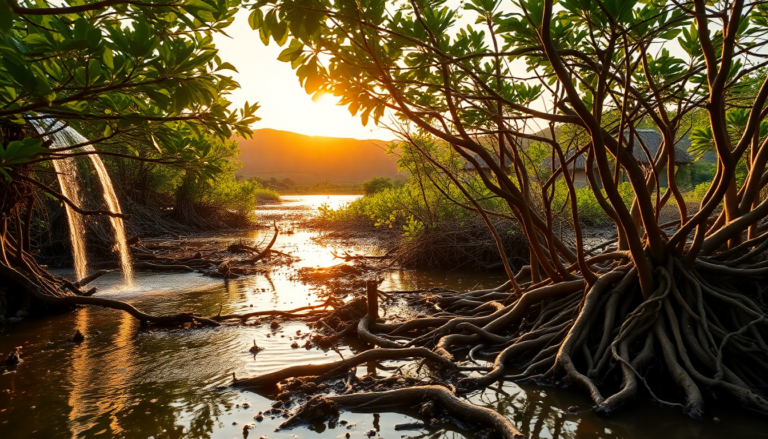Argomenti trattati
Sumba, an island that seems untouched by time, captivates with its wild beauty and rich cultural heritage. Unlike the bustling tourist hotspots of Bali and the Gili Islands, Sumba remains a tranquil haven, where sunsets dance among the mangroves, crystal-clear waterfalls cascade, and ancestral spirits inhabit villages with tall thatched-roof homes. This Indonesian gem invites those seeking an authentic experience far from the crowds.
The allure of Sumba
Located east of Bali, Sumba is nearly twice the size of its famous neighbor yet boasts a population that is significantly smaller. This island is one of the few in the Indonesian archipelago where animistic beliefs still thrive, deeply influencing daily life. Known as ‘The Forgotten Island,’ Sumba offers travelers a chance to connect with nature and immerse themselves in the island’s purest traditions.
Getting to Sumba
The quickest way to reach Sumba is by air, with daily flights operating from Bali (Denpasar) to various destinations on the island. It is advisable to travel from east to west, allowing for an adventurous start and a relaxing conclusion to the journey. Keep in mind that flight schedules can be unpredictable, and if passenger numbers are low, flights may be delayed or canceled. Planning for ample time between connections is wise.
Exploring the landscape and culture
Sumba’s tropical climate is characterized by dry seasons that turn the hills golden, while the wet season brings a vibrant green landscape. Public transportation is scarce, making local drivers and guides essential for navigating the island. Google Maps may not always provide accurate information, and some areas lack signal, so preparing for off-road travel is crucial. However, the roads leading to key attractions are generally well-maintained, and motorbikes can be rented for shorter distances.
The unique Sumbanese horses
The island is also home to the Sandalwood horses, small yet elegant creatures often seen grazing in the hills. These horses are not only a symbol of Sumba but play a significant role in local rituals and ceremonies. It is common to spot them on the beach, ridden bareback by local children, or roaming freely in the countryside.
Community and spirituality
In Sumba, traditional communities reside in villages known as kampung adat, often secluded among the hills or along the coast. The distinctive uma mbatangu houses, characterized by their steep roofs, symbolize the connection between the earthly and spiritual realms. Many villages also feature megalithic tombs, where ancestors are honored through elaborate funerary ceremonies. Walking among these sacred stones invites a sense of reverence and reflection.
Embracing local customs
Visitors are encouraged to dress respectfully when exploring these villages, covering their shoulders and knees. Sumba’s animistic beliefs, particularly those associated with Marapu, emphasize the reverence for ancestral spirits and the sanctity of nature. Each village has its sacred stones and rituals, highlighting the island’s spiritual depth.
The Pasola ritual
One of the most significant events is the Pasola, a ritual tournament in which two groups of horsemen compete with lances. The blood shed during this event is believed to ensure fertility for the fields. This is not a spectacle designed for tourists; it is an authentic, raw, and powerful rite that unfolds without police intervention, even in the case of injuries.
The art of ikat
Ikat weaving is more than just a craft; it is a sacred art form passed down through generations. The process begins with dyeing the threads using natural pigments derived from plants, roots, and minerals, followed by intricate weaving that tells stories and reflects social hierarchies. Each ikat textile, often taking months or even years to create, features symbolic motifs such as horses, shrimp, turtles, and ancestral spirits. Purchasing these textiles supports local communities and allows visitors to take home a piece of Sumba’s rich heritage.
Local craftsmanship
In villages like Prailiu, Kaliuda, and Pau, women continue to weave using traditional techniques. The Sumbanese artistic expression extends to wood carvings depicting animals, Marapu spirits, and scenes from daily life in villages like Tarung and Lamboya. Stone sculptures serve as sacred symbols or grave markers, each piece imbued with deep spiritual meaning.
Traditional music and dance
Music in Sumba serves as a ritual, storytelling, and celebration. The sounds of gendang drums and bamboo flutes accompany hypnotic dances performed during ceremonies and festivities. Each dance conveys significance, whether commemorating a historical event, paying tribute to ancestors, or celebrating a bountiful harvest. The movements are often slow and solemn, evoking an invisible connection to the spiritual realm.
Cultural festivals
Among the most renowned events is the festival featuring horsemen competing in wooden lance-throwing contests. This is not merely a sporting event but a fertility ritual for the fields, typically taking place from February to March, with the exact date determined by the appearance of the nyale worms on the coast. Celebrated by the Wewewa people, this month-long series of spiritual rites includes offerings and animal sacrifices to honor ancestors and purify the community.
Sumba’s evolving tourism
While Sumba begins to open up to tourism, it does so cautiously and with awareness. Visiting the island is not just an opportunity to witness its beauty but also an act of responsibility. The Sumba Foundation plays a vital role in preserving local culture while improving access to education, healthcare, and clean water.
Ultimately, Sumba is not merely a destination; it is a culture to experience, a spirituality to embrace, and a legacy to honor. Each gesture holds significance, every ceremony has ancient roots, and each textile tells a story. Visiting Sumba means stepping lightly into a world that thrives with dignity and resilience, where modernity and tradition coexist in a rare and precious balance.

